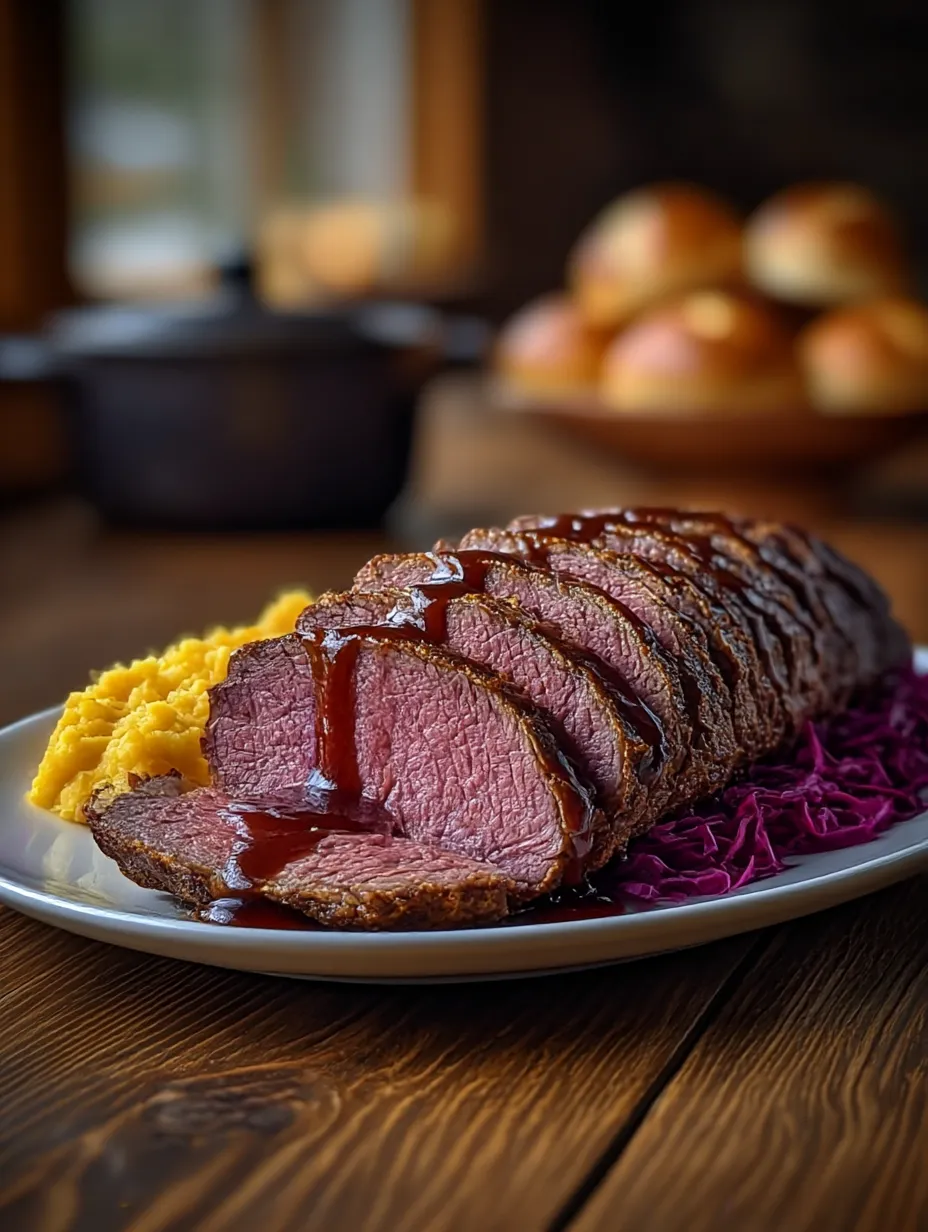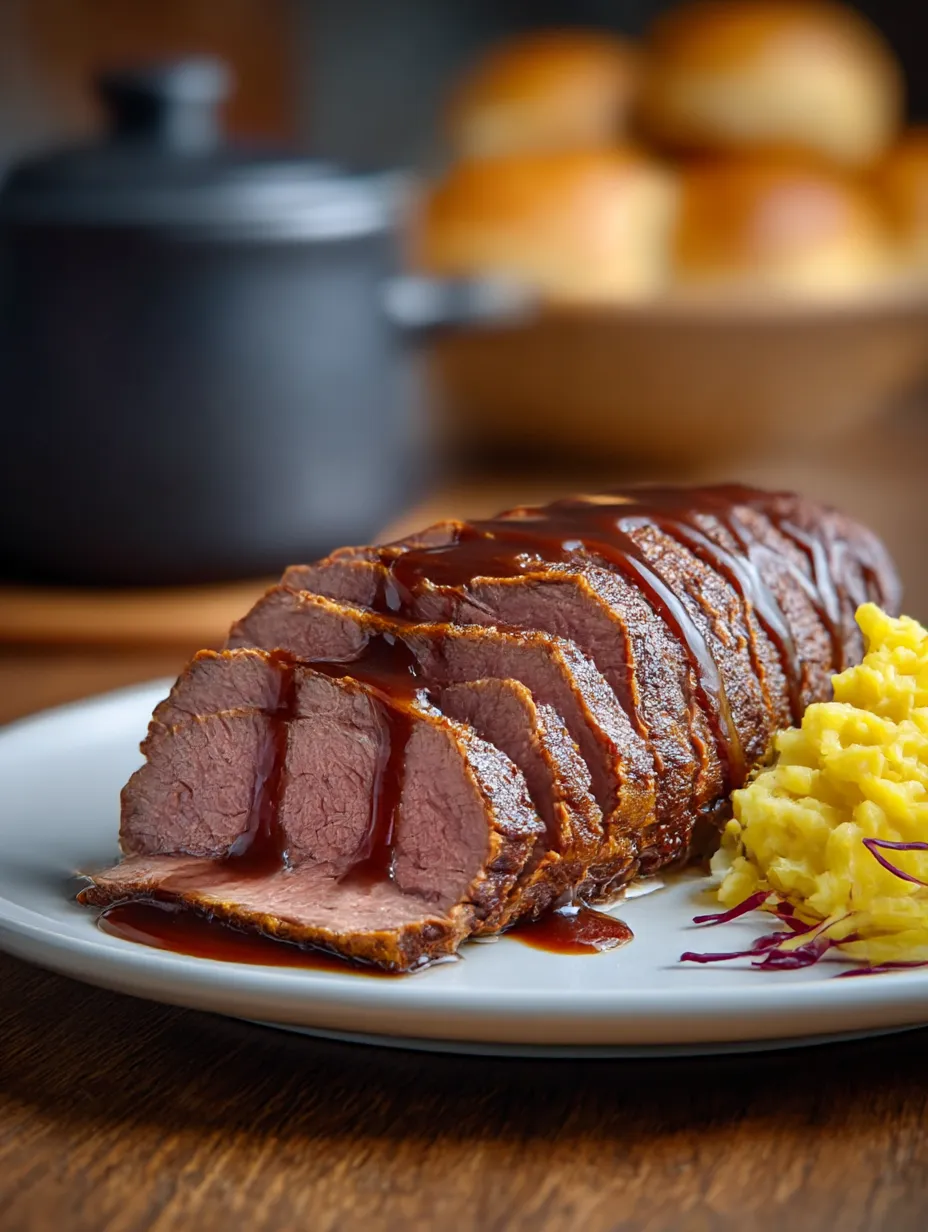 Pin
Pin
German Sauerbraten is the kind of meal that fills your home with a warmth you can almost taste. With its rich braised beef and tangy gravy, this classic German pot roast brings old-world comfort and a touch of celebration to the family table. After making Sauerbraten for countless special gatherings, I can assure you that every step is worth it for that first flavorful bite.
I fell in love with Sauerbraten after tasting it at a friend’s family party. Now my version has become a favorite with my own family and makes our kitchen feel like a home in the Black Forest.
Ingredients
- Beef roast such as chuck or rump: this is key for deep flavor and that signature tender pull
- White vinegar: delivers the dish’s tangy backbone and keeps the meat juicy
- Onion: adds pronounced savory notes and an aromatic foundation
- Brown sugar: balances the acidity with a subtle molasses warmth
- Whole spices like cloves peppercorns and bay leaves: these build layers of earthy and warming taste pick whole spices for best infusion
- Carrots: add natural sweetness that softens the marinade’s bold edges choose firm bright-orange carrots
- Celery: brightens and rounds out the cooking liquid watch for crisp stalks with leafy tops
- Beef broth: enriches the cooking liquid and contributes to the gravy’s depth seek out a low sodium high quality broth
Step-by-Step Instructions
- Marinate the Beef:
- Combine vinegar water whole spices and brown sugar in a saucepan. Gently bring to a boil to dissolve the sugar and infuse the spices. Let this marinade cool fully. Set the beef in a glass or ceramic dish and pour marinade over so it covers the meat entirely. Weight it down if needed and refrigerate for three to four days. Rotate the meat once per day so each side gets a full soak.
- Sear the Roast:
- Pat the marinated beef dry with paper towels. Heat oil in a heavy Dutch oven over medium high until shimmering. Sear the roast on all sides until browned and caramelized. Browning is where you lay the flavor base for both meat and sauce.
- Braise with Vegetables:
- After searing add the strained marinade beef broth onions carrots and celery to the pot with the beef. The liquid should almost cover the roast. Bring to a gentle simmer on the stovetop then cover and transfer to a preheated 325 degree oven. Cook undisturbed two and a half to three hours until the beef can be easily shredded with a fork.
- Make the Gravy:
- Set the cooked beef aside to rest. Pour braising liquid and vegetables through a sieve to catch whole spices then transfer the strained liquid back to the pot. Simmer over medium to reduce and thicken. For a heartier sauce you can dissolve a little cornstarch in water and whisk it in until your gravy reaches your chosen consistency.
- Slice and Serve:
- Once rested slice the beef across the grain and serve with generous ladles of the tangy brown gravy. Be sure to set out some classic sides so every bit of that sauce is enjoyed.
 Pin
Pin
I look forward to the moment I lift the lid after hours of braising and see the beef glistening and almost falling apart. The aroma alone tells you something special is about to hit the table. My youngest always rushes in asking if it is time for his favorite gravy yet.
Storage Tips
Sauerbraten is perfect for leftovers. Store the beef and sauce in separate airtight containers in the fridge for up to four days. You can freeze both for up to three months. To reheat bring the sauce to a gentle simmer on the stove and rewarm the slices in the hot liquid until steaming.
Ingredient Substitutions
If you prefer a milder vinegar swap half the white vinegar for red wine vinegar or even a bit of dry red wine. No brown sugar on hand use a little honey or maple syrup for sweetness. If you cannot find whole spices use the same spices ground just use them sparingly and strain well.
Serving Suggestions
Sauerbraten loves old fashioned sides. Spaetzle or hand rolled egg noodles help sop up the gravy. German potato dumplings are traditional and add more comforting heft. If you like color at your table sweet and sour red cabbage balances the savory notes and looks beautiful on a big family plate.
 Pin
Pin
A Little German History
Sauerbraten dates back to medieval times when cooks preserved beef with vinegar and spices before refrigeration. Every German region has its own twist but all versions are about patience and celebration. Making and sharing this dish feels like connecting with generations of cooks before us.
Recipe FAQs
- → What is the best cut of beef for Sauerbraten?
Chuck or rump roast are preferred for their flavor and tenderness after slow braising.
- → How long should I marinate the meat?
Marinate the beef for at least 3 to 4 days in the refrigerator for the most flavorful and tender result.
- → Can Sauerbraten be made in a slow cooker?
Yes, after searing the meat, transfer it with the marinade and vegetables to a slow cooker and cook on low for 6–8 hours.
- → What sides pair well with Sauerbraten?
Spaetzle, potato dumplings, red cabbage, or mashed potatoes are traditional accompaniments that soak up the savory sauce.
- → How can the sauce be thickened?
Add a cornstarch slurry (1 tablespoon cornstarch mixed with 2 tablespoons water) to simmering sauce and stir until thickened.
- → Is Sauerbraten freezer-friendly?
Yes, the dish freezes well. Store meat and sauce in separate airtight containers for up to 3 months.
